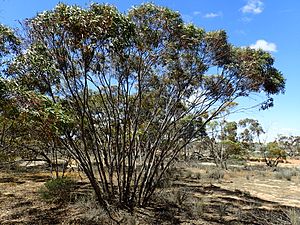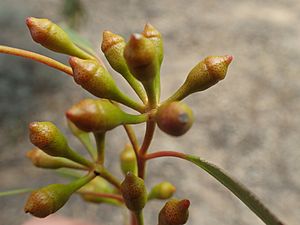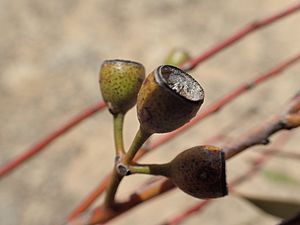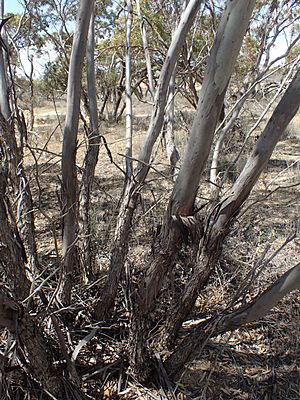Comet Vale mallee facts for kids
Quick facts for kids Comet Vale mallee |
|
|---|---|
 |
|
| Eucalyptus comitae-vallis near Wongan Hills | |
| Scientific classification | |
| Genus: |
Eucalyptus
|
| Species: |
comitae-vallis
|
| Synonyms | |
|
Eucalyptus brachycorys Blakely |
|
The Comet Vale mallee (scientific name: Eucalyptus comitae-vallis) is a special type of eucalyptus tree. It's called a mallee because it usually grows like a big shrub with many stems instead of a single trunk. This plant is endemic, meaning it's only found in the south-west part of Western Australia.
This unique eucalyptus has rough, flaky bark on its main stems and bigger branches. Higher up, the bark is smooth and has a whitish color. Its adult leaves are long and narrow, shaped like a spear. The flowers are white and grow in groups of seven to eleven buds. After flowering, it produces fruit that looks like a barrel, cone, or cup.
Contents
What Does It Look Like?
The Comet Vale mallee is usually a mallee, which means it's a shrub-like plant with many stems. It can grow between 2 to 7 metres (7 to 23 ft) tall. It also has a special woody swelling at its base called a lignotuber. This helps the plant regrow after fires.
Bark and Leaves
The bark on the main stems and larger branches is rough and grey, often peeling off in ribbons. Higher up, the bark is smooth and can be pinkish-grey or yellow-green.
Young plants and new shoots have dull, greyish leaves. These leaves are about 55–80 mm (2.2–3.1 in) long and 10–20 mm (0.39–0.79 in) wide. They always have a small stalk, called a petiole, that connects them to the stem.
Adult leaves are long and narrow, like a spear. They are shiny green on both sides. These leaves are typically 60–100 mm (2.4–3.9 in) long and 6–15 mm (0.24–0.59 in) wide. Their petioles are about 8–15 mm (0.31–0.59 in) long.
Flowers and Fruit
The flower buds grow in groups of seven, nine, or eleven. They appear in the axils of the leaves, which are the angles where a leaf joins the stem. These groups of buds are on a stalk called a peduncle, which is 6–12 mm (0.24–0.47 in) long. Each individual bud has its own smaller stalk, called a pedicel, about 2–6 mm (0.079–0.236 in) long.
When the buds are ready, they are shaped like a cylinder or a narrow pear. They are about 5–6 mm (0.20–0.24 in) long and 3–4 mm (0.12–0.16 in) wide. The top part of the bud, called the operculum, is rounded or flattened.
The Comet Vale mallee flowers from February to April. Its flowers are white. After flowering, the plant produces a woody fruit. This fruit is a capsule that can be barrel-shaped, conical, or cup-shaped. It's about 5–8 mm (0.20–0.31 in) long and 5–7 mm (0.20–0.28 in) wide. The fruit sits on a pedicel 2–8 mm (0.079–0.315 in) long.
How It Was Named
The Comet Vale mallee was first officially described in 1923 by a botanist named Joseph Maiden. He found a sample of the plant near a place called Comet Vale. He wrote about it in his book, A Critical Revision of the Genus Eucalyptus.
The scientific name comitae-vallis comes from Latin. It means "of Comet Vale," which is the place where the first sample of the plant was found. This place is known as the "type location" for the species.
Another botanist, William Blakely, described a similar plant in 1934 and called it Eucalyptus brachycorys. However, experts now agree that Eucalyptus brachycorys is actually the same plant as Eucalyptus comitae-vallis. So, Eucalyptus brachycorys is considered a synonym, or another name for the same species.
Where It Lives
The Comet Vale mallee is mostly found in Western Australia. You can see it between the towns of Menzies and Kalgoorlie. It grows in different regions, including the Mid West, Wheatbelt, and Goldfields-Esperance areas.
This plant prefers to grow in sandy-clay-loamy soils. These are soils that are a mix of sand, clay, and loam (a rich, fertile soil). It typically grows in open shrubland, which is an area with low-growing shrubs and scattered trees.
Is It Endangered?
The Western Australian Government's Department of Parks and Wildlife has looked at the Comet Vale mallee. They have classified it as "not threatened." This means that there are enough of these plants in the wild, and they are not currently at risk of disappearing.




